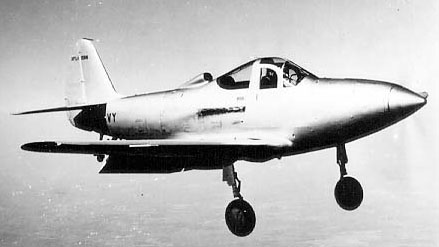- XFL Airabonita
infobox Aircraft
name = XFL Airabonita
caption =
type =Fighter
manufacturer =Bell Aircraft
designer =
first flight = 13 May 1940
introduced =
retired =
status = Cancelled
primary user =United States Navy
more users =
produced =
number built =1
unit cost = $125,000 [Dorr and Scutts 2000, p. 19.]
developed from =P-39 Airacobra
variants with their own articles =The Bell XFL Airabonita was a
United States experimental shipboardinterceptor aircraft developed for theUnited States Navy byBell Aircraft . It was similar to and a parallel development of the land-basedP-39 Airacobra , differing mainly in the use of a tailwheel undercarriage in place of the P-39's tricycle gear. Only oneprototype was manufactured.Design and development
The XFL-1 (Bell Model 5) was powered by a single Allison XV-1710-6
piston engine installed amidships behind the pilot and driving a three bladedCurtiss propeller in the nose through a 10.38 foot (3.16 m) extension shaft. The aircraft had provisions for a single 37 mm (1.46 in)Oldsmobile T9 cannon which could be replaced by a .50 in (12.7 mm)Browning M2/AN machine gun through the propeller shaft and two 0.3 inch (7.62 mm) machine guns in thefuselage nose. It first flew on 13 May avyear|1940.Bowers 1979, pp. 26–30.]Although based on the
P-39 Airacobra the XFL-1 utilised a conventional tail-wheelundercarriage and the coolant radiators were housed externally in fairings under the wings instead of within the wing centre-section. The Allison engine was the first of its type to be tried out by the Navy and lacked the turbo charger fitted to the XP-39. [Note: Navy engines were distinguished by the use of an even dash number while those for the Army used odd ones] .Delivery of the prototype to the Navy was delayed due to difficulties with the Allison engine until February 1941 and it was not accepted as Navy property until March During Navy tests the aircraft was plagued with engine and landing gear problems and was returned to Bell for modifications in December 1941, but before the modifications were completed the Navy decided that the XFL-1 was not suitable for further development.
A further possible reason for the rejection was the often-stated Navy position during that era that all its aircraft should use air-cooled engines (while the Allison was liquid-cooled).Fact|date=August 2008Or|date=August 2008
In addition the Allison engine had only a single-speed supercharger, so its altitude performance was much inferior to other Navy fighters of the period like the
F4F Wildcat (the Army's P-39 and P-40, which used the same engine, had the same difficulty; the P-38 used the same engines but incorporated exhaust-driven superchargers to achieve good altitude performance).Lastly, the Airabonita had to compete against the considerably faster
F4U Corsair , the first US Navy fighter to exceed 400 mph. in level flight.The XFL-1 was later used for non-flying armament tests, and later destroyed. For many years its remains were visible at the dump at
Naval Air Station Patuxent River , Maryland. [Dorr and Scutts 2000, p. 20.]pecifications (XFL-1 Airabonita)
Aircraft specification
plane or copter?=plane
jet or prop?=prop
crew=One
length main=29 ft 9 in
length alt=9.07 m
span main=35 ft 0 in
span alt=10.67 m
height main=12 ft 9 in
height alt=3.89 m
area main=232 ft²
area alt=21.6 m²
empty weight main=5,161 lb
empty weight alt=2,341 kg
loaded weight main=6,651 lb
loaded weight alt=3,017 kg
max takeoff weight main=7,212 lb
max takeoff weight alt=3,271 kg
more general=
engine (prop)=Allison XV-1710-6
type of prop=V-12
number of props=1
power main=1,150 hp
power alt=858 kW
max speed main=307 mph
max speed alt=464 km/h
range main=1,072 mi
range alt=1,725 km
ceiling main=30,900 ft
ceiling alt=9,421 m
climb rate main=2,630 ft/min
climb rate alt=13.4 m/s
loading main=29 lb/ft²
loading alt=140 kg/m²
power/mass main=0.17 hp/lb
power/mass alt=280 W/kg
more performance=
armament=
*2 x 0.30 cal (7.62 mm) machine guns
*1 x 0.50 cal (12.7 mm) machine gun or 37 mm cannonee also
aircontent
related=
*P-39 Airacobra
*P-63 Kingcobra
similar aircraft=References
Notes
Bibliography
*Bowers, Peter M. "Airborne Cobra Pt.II". "Airpower magazine, Vol.9, No.1, January 1979."
* Dorr, Robert F. and Jerry C. Scutts. "Bell P-39 Airacobra". Ramsbury, Marlborough, Wiltshire: The Crowood Press Ltd., 2000. ISBN 1-86126-348-1.
* Green, William. "Bell XFL-1 Airabonita". "War Planes of the Second World War, Volume Four: Fighters". London: Macdonald & Co. (Publishers) Ltd., 1961 (6th impression 1969), pp. 13–14. ISBN 0-356-01448-7.
* Green, William and Gordon Swanborough. "Bell XFL-1 Airabonita". "WW2 Aircraft Fact Files: US Navy and Marine Corps Fighters". London: Macdonald and Jane's Publishers Ltd., 1976, p. 3. ISBN 0-356-08222-9.
* Kinzey, Bert. "XFL-1 Airabonita". "P-39 Airacobra - in detail". Carrollton, Texas: Squadron/Signal Publications Inc., 1999, p. 8. ISBN 1-88897-416-4.
* Tomalik, Jacek. "Bell P-6 Kingcobra, XFL-1 Airabonita, P-39 Airacobra (Monografie Lotnicze 59)" (in Polish). Gdansk, Poland: AJ-Press, 2001. ISBN 83-7237-034-6.External links
Wikimedia Foundation. 2010.
